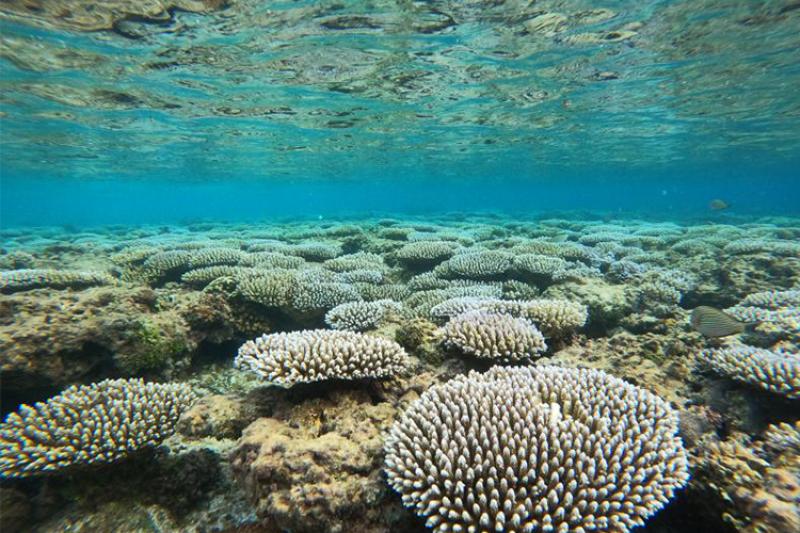They say it takes a village. But sometimes it takes a multi-agency, Pacific-wide collaboration.
With help from NOAA Fisheries, the U.S. Coral Reef Task Force, and local partners, the U.S. territories of Guam and American Samoa are on their way to developing their first sustainable coral reef fishery management plans. Once completed, these plans will chart a path forward to ensure the islands’ marine resources are around for future generations to enjoy.
“The territories are taking a proactive approach in leading their efforts for sustainable coral reef fisheries management,” said Fatima Sauafea-Le'au, American Samoa coral reef fisheries liaison with NOAA Fisheries’ Pacific Islands Regional Office.
Importantly, added fisheries liaison Jonathan Brown, NOAA will have no ownership of the plans. “The resources that will be managed are within the local jurisdictions,” he said. “We are just in a support role, providing tools to help them develop the plans and helping them form partnerships with entities like The Nature Conservancy.”
One such tool is called FishPath. FishPath provides a suite of potential management options for a species based on answers to a lengthy questionnaire about the fishery. And it can be used in data-limited fisheries, like the coral reef fisheries in the Pacific Islands.
Brown and agency partners held a workshop for Guam’s management agencies in June 2022 to teach them how to use the tool to develop management options. These measures could then be incorporated into their sustainable fishery management plans.
American Samoa, with Sauafea-Le'au’s support, held its FishPath workshop in May 2022. It also conducted an analysis of appropriate management options that will help the territory achieve its management goals.
More workshops will be held over the summer and fall, and the local resource management agencies will continue discussions to refine their management options. They’ll also work with community members whom the measures would affect.
“This initial workshop,” Brown said, “was just the first step of the process.”
Charting a Path
Guam’s fishery management representatives, including Department of Agriculture director Chelsa Muña-Brecht and Division of Aquatic & Wildlife Resources chief Jay Gutierrez, attended the FishPath workshop. Other attendees included scientists with NOAA Pacific Islands Fisheries Science Center, the University of Guam, and the University of Hawaiʻi. The American Samoa planning team is led by the Department of Marine and Wildlife Resources, the Coral Reef Advisory Group, and the Pacific Islands Regional Office. The advisory group includes members such as the American Samoa Environmental Protection Agency, National Marine Sanctuary, and Community College.
Prior to the 5-day workshops, facilitated by The Nature Conservancy and NOAA Northwest Fisheries Science Center, attendees went through part of the FishPath tool on their own for the islands’ respective management plan priority coral reef fish species. During the workshop, they reviewed selected species questionnaires. The facilitators led discussions to formulate and understand management options and work through non-consensus answers.
“The real value of FishPath is not just coming up with options for management,” Brown said. “It’s a tool that really generates open discussion. It’s transparent and creates this level playing field of understanding.”
The tool provided a list of possible management options, graded on viability, which the facilitators helped whittle down to a smaller list. Some options were contentious for various reasons. For example, they didn’t help the fishery quickly enough, contained too many variables to understand their full effect, or were too costly.
In the end, the collaborators landed on two potential measures that would protect reproducing females and their egg-producing capacity. These include establishing size limits and reducing the number of adult fish that can be legally caught. These measures will ensure that the fishery has the reproduction and recruitment necessary to be sustainable.
The Path Forward
Given limitations on capacity, funds, and knowledge, taking a species-level approach to managing the fisheries doesn’t seem viable, Brown explained. Instead, Guam and American Samoa will likely focus on so-called indicator species.
Fish species can be grouped in various ways, such as by family (groupers, snappers, etc.) or functionally (herbivores, carnivores, etc.). Within a given group, the health of certain species will often be defined by their life history and biology. By grouping species, managers can infer how the population of one species in a group is doing based on the indicator species. Managers can then use the indicator species to develop management measures for the group, and monitor that species to assess the overall health of the group.
Guam’s fishery managers will likely have another workshop focusing on indicator species. They’ll then share their resulting management measures with the community, making sure the fishing community can contribute to the knowledge and help build the plan. Similarly, American Samoa will use the FishPath tool for its remaining pool of indicator species and take this collection of information into a second workshop to begin framing its plan, according to Sauafea-Le'au.
Fisheries management is an active and adaptive process. It requires close monitoring of the resource. American Samoa and Guam will have to develop assessment tools to monitor and evaluate the health of their managed species and effectiveness of their management plans.
A school of convict tang (Acanthurus triostegus) graze algae from a reef in Guam, an important ecosystem service that herbivorous fish perform in maintaining healthy coral reefs. Credit: NOAA Fisheries
“On small islands, we’re so tied to the fish and our resources,” Brown said. “We’re doing this for our future generations.”







